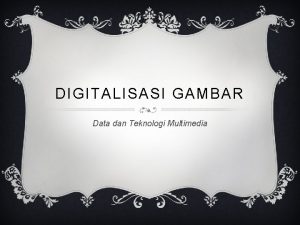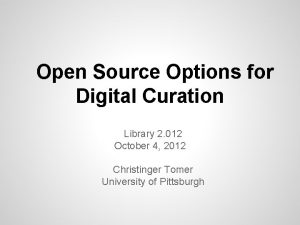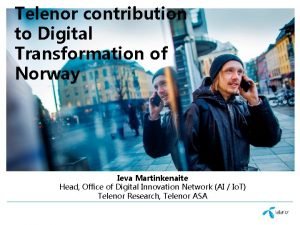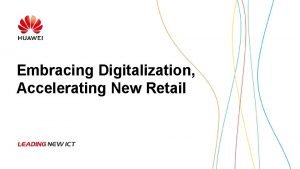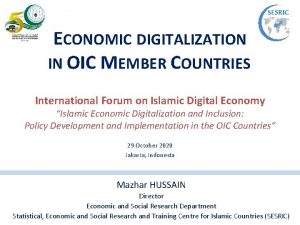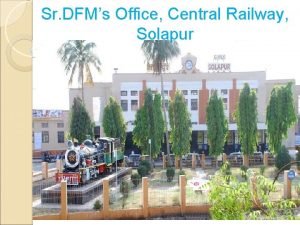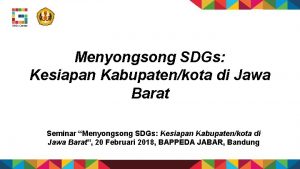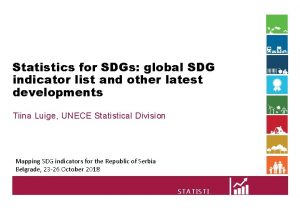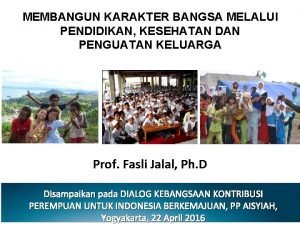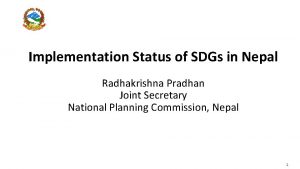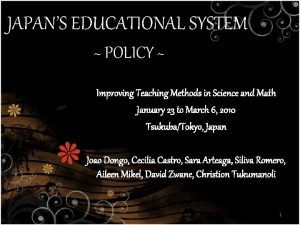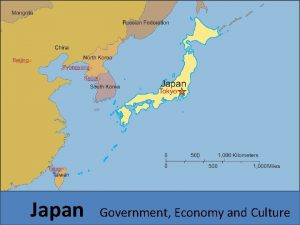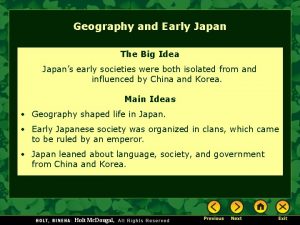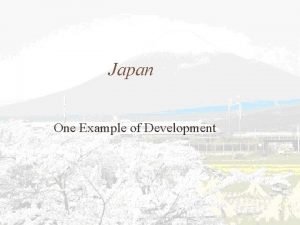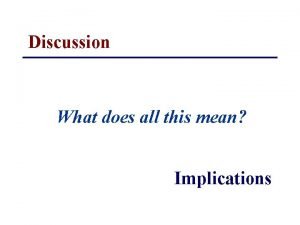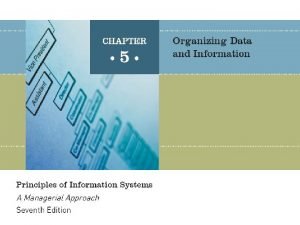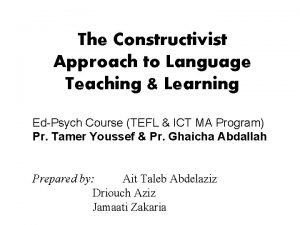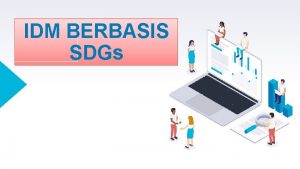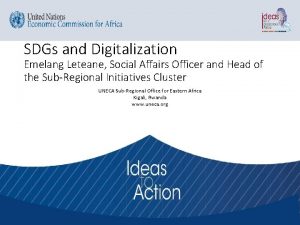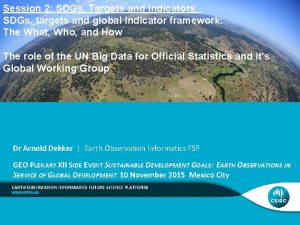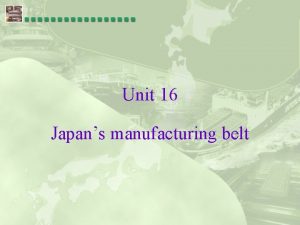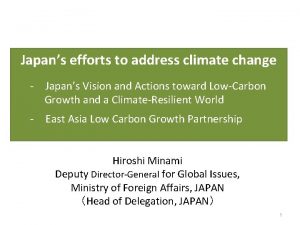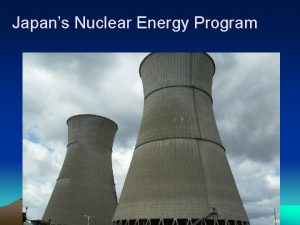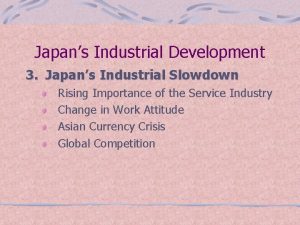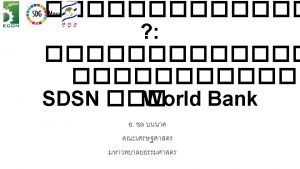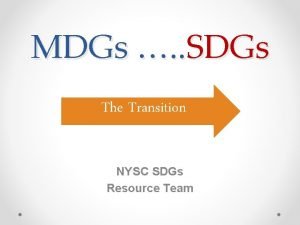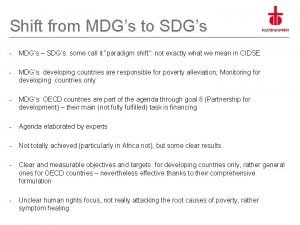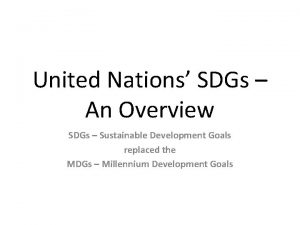Digitalization of Innovation and Implications for SDGs Japans






























- Slides: 30

Digitalization of Innovation and Implications for SDGs: Japan’s Experience of Developing Smart Cities Masaru YARIME City University of Hong Kong Japan International Cooperation Agency Research Institute 18 th Global Development Conference Science, Technology, and Innovation for Development New Delhi, India, 22 -23 March 2018

Conventional Model of the Innovation Process 1 Greenhalgh & Rogers (2010)

Digitalization of Innovation • Internet of Things (Io. T) – Different things previously separate increasingly connected • Big Data – Vast amount of various types of data available through diverse sources • Digital Platform – Increasing amounts of data collected and connected • Artificial Intelligence (AI) – New findings through machine learning 2

Implications of Digitalization of Innovation • Improvement in production processes (smart factories) – Increased efficiency in energy and material use in independent technologies • Effective matching between supply and demand sides (ride sharing) – Increased efficiency in energy and material use in systems – Wider and better access to products and services • Integration of cyber and physical systems – Skill and capacity building for algorithm development and data access and collection • Critical role of digital platform – Network effects in providing and utilizing data 3

Smart Cities based on Data Exchange for Efficient Matching between Supply and Demand Sides Source: Fuji Electric 4

Integration of Various Functions in Smart Cities Community Energy Management System for optimizing energy supply and demand Nuclear Power Plant Thermal Power Plant Power Line Free LRT Smart Building Large Energy Storage Utilize Electric Car As a part of energy infrastructure Wind Power LRT with Battery At the station: Charge to battery Between stations: Move by battery LRT Utilize Natural Wind Flow ITS Control Center Mega Solar Quick Charging Station 80% charge in 30 minutes Electric Bus Shortage: EV→ House Excess: House → EV Electric Car Smart House Micro Hydraulic Plant Smart House Electric Bus (works like LRT when connected) Photovoltaic Cell Battery Replaceable Bus / Works like LRT by connecting multiple buses Dryer/Washer Dish Washer LED Light Television Li-Ion Battery (Fixed) AC Inverter Smart Meter Motor Home Area Network Home Gateway Air Conditioner Heat Pump Water Heater METI (2012) Electric Car Li-Ion Battery (Replaceable) Connected buses will operate like LRT 5

Key Components of Smart Cities 6

7

Societal Challenges Addressed in Smart Cities • Upgrading aging and deteriorating infrastructure for energy distribution • Reducing environmental burdens (CO 2 emissions, air pollution) by increasing renewable energy sources and efficient energy usage • Strengthening the resilience of the supply of energy and services against disruptions and disasters (earthquakes, typhoons, hurricanes) • Coping with cost pressure to improve energy efficiency and to cut back its consumption during peak periods 8

Technological Domains Related to Smart Cities • Information and Communication – Grid control software; sensing, automation and control; communication infrastructure; conductor technology and approaches; load control and advanced metering infrastructure • Energy – energy management systems, photovoltaics, energy storage, smart houses, electric vehicles, demand‐response systems, distributed renewables, co‐generation, district heating and cooling, energy‐efficient lighting, advanced HVAC systems • Building and Housing – New construction technologies and designs, life‐course design and optimization, sensing and actuation for real‐time space management, adaptive space design, financing, codes, and standards conducive to innovation • Transportation – Multi‐modal integration via ICT applications and models, On‐demand digitally enabled transportation, Design for biking and walking, Electrification of motorized transportation, Autonomous vehicles IEA (2010), President’s Council of Advisors on Science and Technology (2016) 9

Diversity in Creating Innovation for Smart Cities • Societal Challenges • Stakeholders • Technologies • Need to incorporate specific local conditions and contexts in policy making for smart cities 10

Elements of Innovation Systems • Knowledge and Technological Domains – Specific knowledge base and specific technologies and inputs needed for research, production, and distribution • Actors and Networks – Heterogeneous agents including firms, non‐firm organizations (universities, financial organizations, industry associations) and individuals (consumers, entrepreneurs, scientists) • Institutions – Norms, common habits, established practices, rules, laws, and standards, influencing the actions and interactions of actors producing and using knowledge • An innovation system undergoes processes of change and transformation through the co‐evolution of its various elements. 11

Functions of Innovation Systems Development of Positive Feedback Resource Mobilization Knowledge Creation and Diffusion Societal Guidance Innovation System Creation of Legitimacy Entrepreneurial Activity Market Creation 12

Knowledge and Technology Domains Concerning Smart Cities Japan: PVs, distributed energy, and energy storage, home appliances, electric vehicles, community energy management Yarime and Karlsson (2018) US: smart grid, smart meter technologies, communication network 13

Network of Actors in Developing Smart Cities Japan: concentrated structure dominated by a small number of large actors, e. g. energy & electric companies and public organizations Yarime and Karlsson (2018) US: distributed structure with many actors, such as utilities and ICT companies including SMEs and start-ups 14

Major Actors in Japanese Innovation System of Smart Cities Hitachi TOSHIBA Mitsubishi Corporation NEDO Type Electronics company Trading company Governmental funding agency Degree 74 64 67 28 ARD 303 298 299. 1667 265. 3333 Eigenvector 0. 173066 0. 165316 0. 171806 0. 044392 Betweenness 5212. 703 3735. 588 2908. 344 2735. 742 Sharp Consumer electronics company 91 262. 4989 0. 243331 1603. 521 Denso Automotive component supplier 55 293 0. 174657 1567. 229 Fuji Electric JX Nippon Oil & Energy Panasonic Furukawa Electric University of Tokyo Sumitomo Electric Industries Urban Renaissance Agency TOTO Infrastructure vendor Petroleum company Electronics company Infrastructure vendor University Infrastructure vendor Real estate agency White ware vendor 53 55 35 47 13 55 47 30 277. 6672 293. 5 283. 5 272. 5004 269. 5 293. 5 275. 5005 278 0. 141623 0. 166895 0. 098062 0. 132096 0. 025997 0. 160089 0. 123371 0. 101322 1516. 667 1481. 08 1276. 681 1187. 081 1154. 299 1123. 101 960. 8317 917. 3737 IBM Omron Software vendor Automotive component supplier 30 24 278 275 0. 101322 0. 061349 917. 3737 770. 785 Kansai Electric Power Co Iwatani Electric utility Gas equipment vendor 24 29 275 263. 3333 0. 061349 0. 098677 770. 785 658. 7583 Nittetsu Elex Tokyo Gas Infrastructure vendor Gas utility 29 31 263. 3333 281. 5 0. 098677 0. 089186 658. 7583 609. 840615

Major Actors in US Innovation System of Smart Cities Type EPRI Degree Research institute ARD Eigenvector Betweenness 28 194. 8334 0. 113018 7995. 122 Electronics company 29 199. 6667 0. 122854 7513. 267 Meter vendor Electric Utility Software vendor 17 17 16 178. 0835 186. 2501 181. 8334 0. 048041 0. 086227 0. 069304 6957. 279 3986. 014 3706. 082 26 189. 8333 0. 133678 3650. 072 15 143. 1001 0. 022026 3307. 329 Premium Power Electric utility Infrastructure vendor 8 135. 2502 0. 013672 3255. 385 Aclara Infrastructure vendor 10 170. 0001 0. 049314 2633. 994 Eaton Infrastructure vendor 12 175. 3334 0. 065682 2546. 157 RTO Meter vendor Consultancy firm 8 10 174. 25 177. 25 0. 055321 0. 062162 2383. 878 1970. 951 4 169. 5833 0. 051425 1970 Science Applications International Infrastructure vendor 8 105. 0667 0. 001076 1970 Oncor DTE Energy Electric utility Infrastructure vendor 19 2 183. 4167 165. 5 0. 12121 0. 041463 1877. 981 1749. 594 8 178. 2501 0. 07408 1740. 068 Electric utility Infrastructure vendor 18 188. 5001 0. 134307 1677. 09 12 148. 4667 0. 038026 1660. 706 Electric utility 8 138. 0169 0. 020919 GE Sensus Landis+Gyr Southern California Edison IBM Pacific Gas & Electric Company PJM Interconnection Itron Navigant Cooper Power Systems American Electric Power S&C Electric Austin Energy 158016

Innovation Systems of Smart Cities Driven by Energy Sector in Japan and ICT Sector in US Japan • Strong interest in resilience to natural disasters and distributed energy systems • Focus on application technologies for home appliances and electric vehicles, energy storage, community management • Concentrated structure dominated by a small number of large actors, including government organizations and electric & electronic companies • Innovation system mainly driven by the energy sector US • Strong interest in resilience to physical and cyber attacks and cost reduction • Focus on grid and smart meter technologies, communication, infrastructure network • Distributed structure with many actors, such as utilities and smart meter manufacturers including SMEs and start‐ups • Innovation system mainly driven by the information and communication sector 17

Policies Influencing the Innovation System of Smart Cities • Reform of the energy market • Financial support for renewable energy sources • Participatory road‐mapping on the development of key technologies • Demonstration projects through stakeholder collaboration • Standard setting for data exchange and communication through smart meters and devices • International implementation of smart cities 18

From Technological Development to Societal Experimentation • Traditionally support provided through the funding agency New Energy Development Organization (NEDO) • Prior to 2000: Development of individual technologies for introducing renewable energy to grid • 2000‐ 2010: Development and demonstration of multiple, large‐scale technologies coordinated for introducing renewable energy sources to the grid • 2010‐: Experimentation of smart cities addressing societal needs and involving stakeholders 19

Local Differentiation of Demonstration Projects (2011‐ 2015) Keihanna Science City Yokohama Housing Complex Wide‐Area Metropolis ‐ Visualization of energy for control and management ‐ 700 households and HEMS ‐ Consulting business for energy saving ‐ Large‐scale introduction of renewable energy and electric vehicles ‐ 4, 000 households and HEMS ‐ 10 large‐scale building BEMS. ‐ Multiple storage batteries Kitakyushu Toyota City Designated supply area Separate housing ‐ Optimization of various sources of energy ‐ Power supplied by Nippon Steel & Sumitomo Metal Corporation. ‐ Dynamic pricing system for 180 households ‐ Local production for local consumption ‐ 67 households equipped with solar panels, household fuel cells, storage batteries ‐ Advanced transportation system (EV, PHV) GE 20

Facilitating Technological Integration, Reliability, and Learning through Demonstration • Verifying emerging advanced technologies for smart cities increasingly connected and integrated (renewable energy, energy storage batteries, and energy management systems) • Exploring robust business models with active participation of relevant stakeholders, including local communities and residents • Large‐scale adoption and intensive learning for the price of component technologies and the cost of operating energy systems to decline, encouraging their deployment in smart cities 21

Standard‐Setting for Smart Meters and Equipment • Proprietary standards among competing providers having slowed down the market to take off • Open Automated Demand Response (Open. ADR) 2. 0 technology standard adopted following feasibility, interoperability and connectivity testing in the summer of 2013 • With an application programming interface (API), the efficient development of applications facilitated, including HEMS and BEMS. • Adoption of HEMS driving Japan's smart household appliance industry, as LED lights, smart thermostats, plug‐in electric vehicles, rooftop solar, demand‐flexible water heaters, battery energy storage, and other appliances integrate with the IT network, with HEMS Alliance formed by leading companies to prepare a multi‐vendor device environment • Various standards emerging rapidly for the Internet of Things (Io. T) (e. g. , Zig. Bee, Bluetooth Low Energy), leading to a need to consider coordination 22

Coordinating Various Functions of the Innovation System of Smart Cities Research and Development Standard‐Setting for Smart Devices Public Funding Development of Positive Feedback Resource Mobilization Demonstration Projects Involvement of Acaddmia, Citizens and Public Sector Yarime and Karlsson (2018) Stakeholder Consortia Knowledge Creation & Diffusion Government Targets & Initiatives Societal Guidance Innovation System Entrepreneurial Activity Creation of Legitimacy Market Creation Disasters & Accidents Start‐ups & New Entrants Economic Incentives to Renewables Electricity Markt Reform 23

Challenges in Facilitating Innovation for Smart Cities • Clear visions and matching with implementation • Strong leadership and transparency • Coordination among various standards in different fields and sectors • Serious and active participation of end users • Asymmetry of knowledge and expertise between large technology companies and local government and communities • Robust business models • Taking over the demonstration projects initiated with public funding by private actors • Human resources with skills and capacities to understand integrate technical and social dimensions • Availability, accessibility, and ownership of data 24

Challenges in Open Data • What Incentives can be provided to various stakeholders for publishing and sharing data? • Who can have and how to control accessibility to data? • How to control the quality of the data? • Who owns the data and who can use it for what purposes? – Increasing integration of data in various fields, including energy, transportation, housing, etc. – Possibility of individual ownership of data and data portability 25

Policy for Open Data • Japan’s privacy law revised to introduce a concept of anonymously processed information to facilitate and legitimize business analytics and positive use of big data • The new change in privacy law allows organizations to process or transfer customer information after data being anonymized. • If customer identity details, including names, biometric information and government issued numbers, are all removed, no consent is basically required, whether the data is aggregate or not. 26

Coordination of Policy Making in Relevant Fields Concerning Smart Cities • • • Energy Policy Environmental Policy Science, Technology and Innovation Policy Industrial and Competition Policy International Trade and Investment Policy Information and Data Policy 27

Policy Challenges in Developing Smart Cities • Regulatory Reform for Market Entry – Start‐ups and new entrants from different sectors • Institutional Design of Incentives – Priority setting, economic mechanisms • Support for R&D and Entrepreneurship – Increase in R&D expenditures, lean start‐up • Implementation of Pilot Projects – Trial and error through living laboratories • Open Data – License conditions for utilities, transportation, and telecommunication companies on disclosure and use of customer data 28

Integrating Technologies and People Smart City 1. 0 Smart City 2. 0 Focus of Vision • Technology‐driven, business‐oriented • People‐centered Role of Citizens • Passive role as sensors, end‐users/consumers • Active role as co‐creators or contributors to innovation, problem solving and planning Objective of • Optimize infrastructures Technology and services Experimentation • Serve user demands and spur new business opportunities • Efficiency through ICT and big data Approach • Top‐down, centralised Cf. Crowley, Nutter et al. (2016), Nomura (2017), Trencher (2017) • Solve social challenges • Enhance citizen wellbeing and public services • Legitimacy through participation and transparency in decision making and consensus building • Bottom‐up, decentralised, inclusive to diverse stakeholders 29
 Digitalisasi gambar
Digitalisasi gambar Apache tomcat digitalization
Apache tomcat digitalization Ieva martinkenaite
Ieva martinkenaite Digitalization
Digitalization Digitalization of infrastructure
Digitalization of infrastructure E sr digitization
E sr digitization Moving towards digitalization
Moving towards digitalization Sdgs jawa barat
Sdgs jawa barat Sdg project ideas
Sdg project ideas Sdgs list
Sdgs list Mnemonics to remember sustainable development goals
Mnemonics to remember sustainable development goals Https://sustainabledevelopment.un.org/sdgs
Https://sustainabledevelopment.un.org/sdgs Pilar lingkungan sdgs
Pilar lingkungan sdgs Sdgs 2030
Sdgs 2030 Sdgs
Sdgs Sdgs
Sdgs Sdgs
Sdgs Japans educational system
Japans educational system Japans type of government
Japans type of government Japans physical geography
Japans physical geography Geography of japan
Geography of japan Japans first capital
Japans first capital Japan hot xxxx
Japan hot xxxx Japans geography
Japans geography Japanese feudal hierarchy
Japanese feudal hierarchy Innovation for the sake of innovation
Innovation for the sake of innovation Disruptive and radical innovation
Disruptive and radical innovation Discussion and implications
Discussion and implications Implications of database approach
Implications of database approach Constructivist approach to language learning
Constructivist approach to language learning Implication table state minimization
Implication table state minimization
